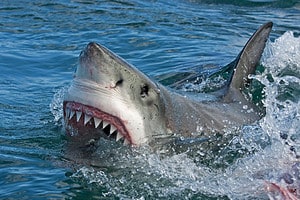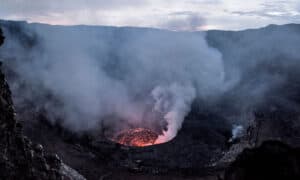Great whites are one of the most terrifying and aggressive creatures of our time. They can weigh up to 5,000 pounds and grow as long as 20 feet. These sharks are apex predators and can only be challenged by a few animals. In fact, the only animal that poses a threat to an adult great white is the killer whale – and not just a single one, but a pack!
But what if there was another animal that once swam the earth and was large and strong enough to bite the great white shark in two? Interesting, such an animal existed and it was a fish. Let’s learn about the terrifying fish that ruled the earth’s waters long before humankind.
Meet Dunkleosteus Terrelli
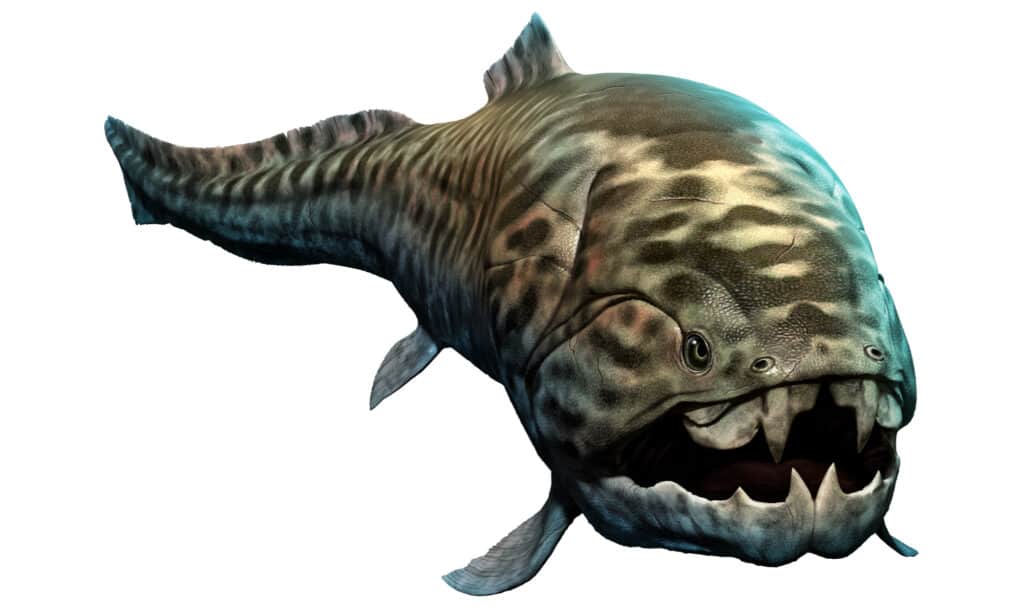
Adult Dunkleosteus had strong jaws that could crush anything, enabling them to attack bigger prey.
©Warpaint/Shutterstock.com
Dunkleosteus terrelli is an extinct species of fish under the Dunkleosteus genus. All 10 species of the genus are identified by their large jaws and armored bodies, but Dunkleosteus terrelli stands out from the rest. The species is the largest in the genus and one of the largest armored fish ever.
Although there are multiple accounts of how large this giant was, we can say that it was around 28.8 to 33 feet long. Dunkleosteus terrelli also weighed more than 8,000 pounds, making it one of the largest fish to ever exist. This mega fish is classified as placoderm, a group of prehistoric plate-skinned fishes.
How Did Dunkleosteus Get Its Name?
(Image Caption: In 1956, Dunkleosteus was named in honor of David Dunkle, a former curator of Vertebrate Paleontology.)
In 1956, Dunkleosteus was named in honor of David Dunkle, a former curator of Vertebrate Paleontology. Dunkleosteus combines “Dunkle” and the Greek word “ὀστέον,” which translates to “bone.” This means that “Dunkleosteus” literally means “Dunkle’s bone.”
David Dunkle worked at the Cleveland Museum of Natural History and then at the Smithsonian Museum of Natural History, where his work on fish fossils gained him much recognition.
The discovered fossils showed that Dunkleosteus terrelli lived in many parts of Europe and the United States. Some states where fossils were found include Ohio, Tennessee, California, Texas, and Pennsylvania. Luckily, many other states in America, including New York, Washington, and Illinois, have Dunkleosteus terrelli fossils on display.
The species is believed to have inhabited shallow waters as juveniles and adolescents before moving to deep-sea locations as adults. This is a trait shared by other fishes classified as placoderms.
How Fast Could Dunkleosteus Terrelli Swim?
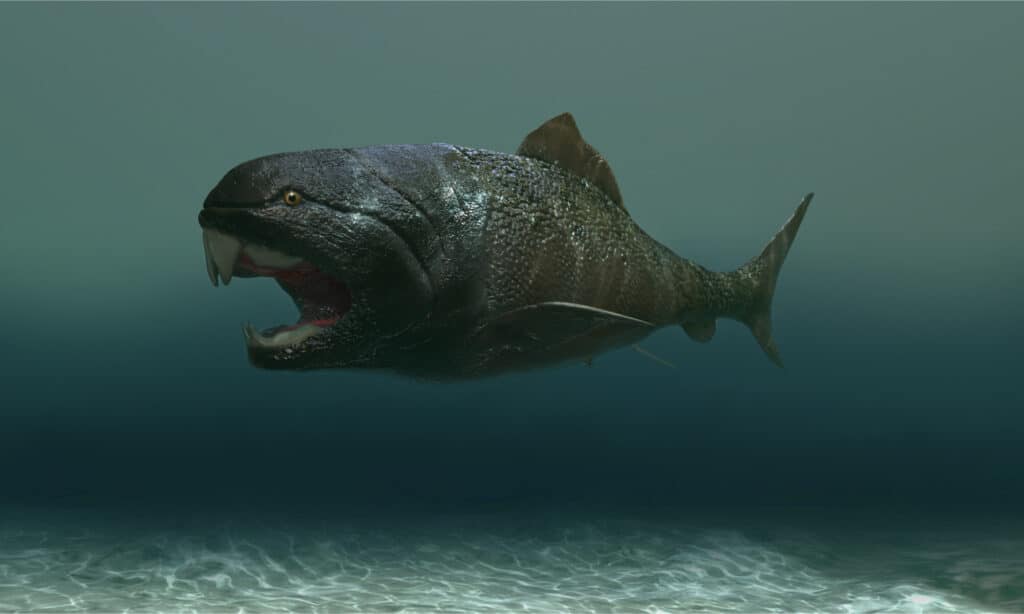
Dunkleosteus had a two-part bony, armored exterior that made it a slow but powerful swimmer.
©Esteban De Armas/Shutterstock.com
Although scientists believe that Dunkleosteus terrelli was a powerful swimmer, its heavy body armor would have made it slow. However, it’s worth noting that many other placoderms or armored fishes adapted to fast swimming at the surface and bottom of the ocean. So, while we can estimate based on the few available facts, it is possible that Dunkleosteus terrelli was a powerful and fast swimmer.
Without its powerful swimming strength, it would have starved due to its inability to hunt the large prey it fed on. As a juvenile, Dunkleosteus terrelli preyed on small sharks and bony. But as it got older, its diet expanded, and its prey got bigger. Research shows that its jaw became stronger and wider with age, which increased its predatory abilities.
Adult Dunkleosteus terrelli preyed on armored prey such as ammonites and even other placoderms. However, scientists believe it didn’t digest the bones of these animals but regurgitated them.
Dunkleosteus Terrelli’s Jaws and Teeth
(Image Caption: Dunkleosteus Terrelli’s teeth ground against each other and sharpened themselves.)
Like many fish today, Dunkleosteus terrelli didn’t have typical teeth. Instead, it had four sharp bony plates, which were arranged in groups of twos. These plates would “grind” against each other, acting as a self-sharpening mechanism. Together, they looked similar to canines and tore prey into shreds.
Due to the structure of its teeth, Dunkleosteus terrelli could open its mouth really swiftly and clamp down on its prey with massive force. In addition, many research scientists, such as Philip S.L Anderson and Mark W. Westneat, believe there is a link between how Dunkleosteus terrelli fed and how modern-day suction feeders do.
According to a paper published by both researchers, this mega fish had a highly kinetic skull that worked with a four-bar linkage mechanism. This allowed Dunkleosteus terrelli to open its jaws fast, resulting in a rapid expansion phase seen in modern suction-feeder fishes.
Could Dunkleosteus Terrelli Have Defeated a Great White Shark?
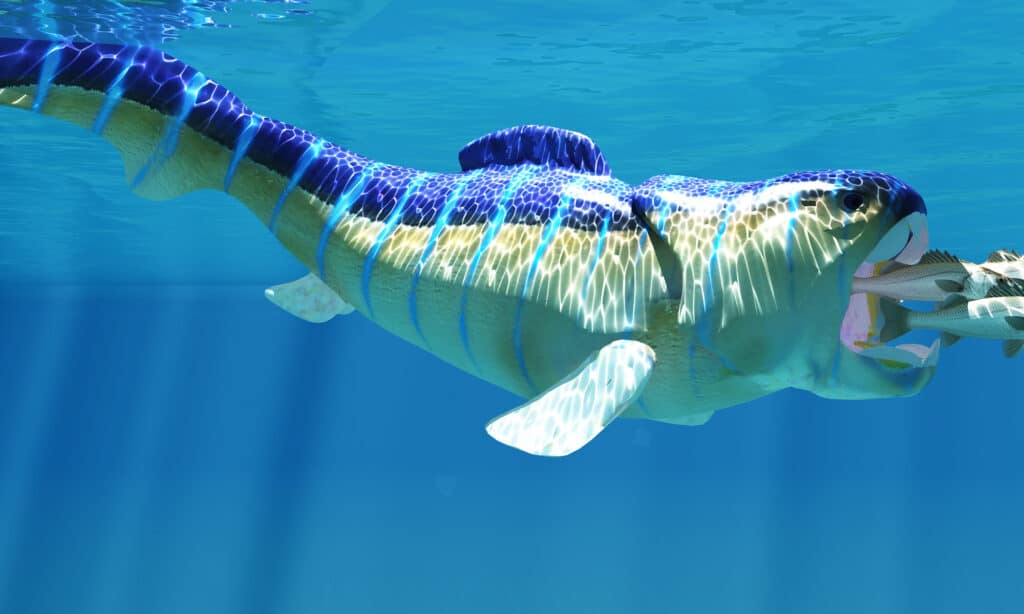
Dunkleosteus had strong jaws that could chop up sharks and other marine creatures.
©Catmando/Shutterstock.com
Studies approximate that Dunkleosteus terrelli had a bite force of 8,000 pounds per square inch at the tip of its fangs. But that’s not all: some parts of its jaws had an approximated bite force of an astonishing 80,000 pounds per square inch.
This greatly trumps the bite force of the saltwater crocodile, which is known as the animal with the heaviest bite force of any living creature. Its bite force is capped at 3,700 pounds per square inch, which is less than half of Dunkleosteus terrelli’s bite force at only the tip of its fangs.
With this bite force, you may wonder, “Could Dunkleosteus terrelli have defeated a great white?” According to the experts, it could have.
Mark Westneat is one of the curators of fishes at the Field Museum in Chicago, Illinois – one of the museums with the Dunkleosteus terrelli fossil on display. In an interview with Live Science, he stated he believed a Dunkleosteus terrelli could have defeated a great white up to 20 feet long. His belief is based on a model of the shark’s jaws made by him and Philip Anderson, the project lead.
Anderson, who works at the department of Geophysical Sciences at the University of Chicago, also stated that Dunkleosteus terrelli destroyed everything in its environment. Many scientists and paleontologists refer to Dunkleosteus terrelli as an apex predator, which aptly describes its strength. It was one of the first apex predators and remained so until its extinction.
Sadly, Dunkleosteus terrelli went extinct about 359 million years ago. It didn’t fall to any species but to a mass extinction caused by the Hangenberg Event. The Hangenberg Event caused marine oxygen levels to drop drastically and wiped out more than 70% of all species on earth.
Bonus: Could Dunkleosteus Bite a Megaladon in Half?
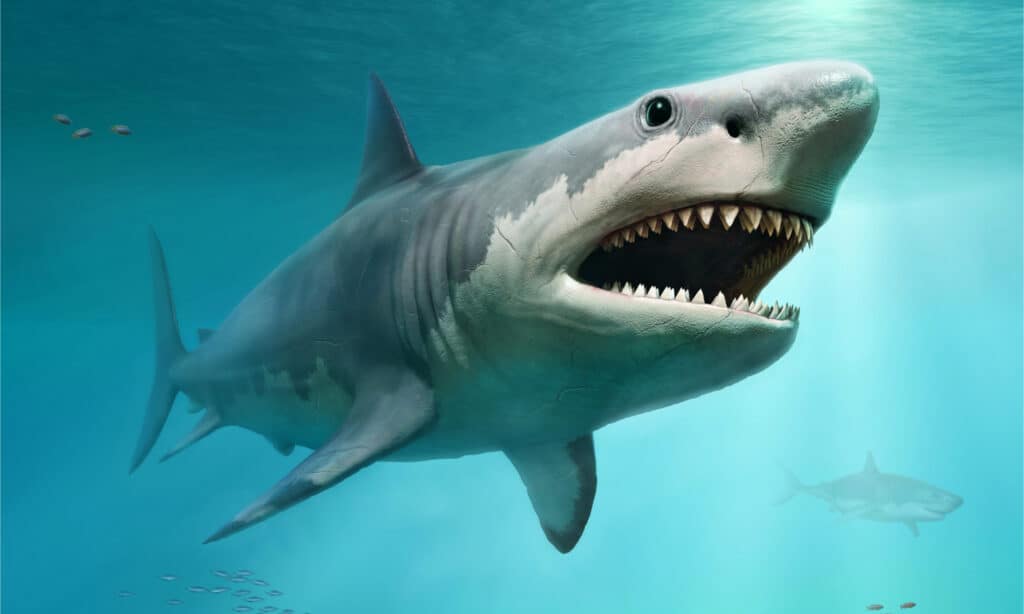
Megaladon weighed as much as 30 large great whites, reached over 60 feet in length, and ate 2,500 pounds of food each day!
©Warpaint/Shutterstock.com
Dunkleosteus and megalodons ruled the oceans 300 million years apart and never encountered each other – but it’s fun to think about a sea monster battle between these two! Megalodon was definitely bigger – much bigger. Megalodons grew to 67 feet long and weighed 100,000 pounds! A 4,000 pound Dunkleosteus was the size of a meg’s prey. Megalodons were even stronger than the powerful Tyrannosaurus Rex!
Even though Dunkleosteus had body armor for protection and could ram and stun the megalodon – the largest shark that ever lived was faster with a bite force of 40,000 PSI. It would have been no contest – the mighty Dunkleosteus would have been shark food!
The photo featured at the top of this post is © Esteban De Armas/Shutterstock.com
Sources
- Ohio Story Connection, Available here: https://www.ohiohistory.org/exploration-hq-highlight-dunkleosteus-jaw/
- National Library of Medicine, Available here: https://www.ncbi.nlm.nih.gov/pmc/articles/PMC2373817/
- Research Gate, Available here: https://www.researchgate.net/publication/309649739_Jaw_Ontogeny_of_the_Late_Devonian_T_rex_with_implications_for_feeding_strategies_and_life_history_of_the_arthrodire_Dunkleosteus_terrelli/link/581b88a008ae40da2ca90f01/download
Thank you for reading! Have some feedback for us? Contact the AZ Animals editorial team.




